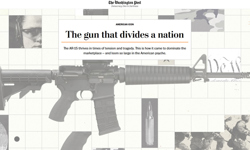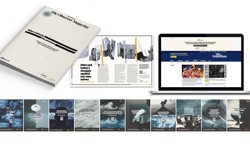Had we but world enough, and time,
This coyness, Lady, were no crime…
I recently attended an excellent Cambridge-MIT seminar on the future of media. Many of the great and the good representing the digital aspects of some of our major print and broadcast brands were there, and there was a high level of consensus on the way that things are looking for our business. Because it was held under Chatham House rules, I can’t go into detail on what was said by whom, but one quote from a US delegate sums up the general mood of the seminar: "newspapers are dead but it will take a while for the body to cool down".
Personally, I don’t agree with the doomsday scenario. For a start, I heard it too often in the heady days of the 90’s hyperbabble of the dotcom boom (and didn’t believe it then either). Also, I’m of the "never say never and never say forever" school of punditry, and I don’t think the evidence from any other new technology or media rollout is clear enough to indicate the impact of digital delivery on analogue formats (to the extent of death by strangulation at least). There’s plenty of evidence that innovative change forces market change, and sometimes complete dismissal from the field of battle, but not always as quickly as you’d think:
* The railway boom of the 1840’s in Britain was not dissimilar to the dotcom boom – it even had its own Bernie Ebbers, in the shape of the disgraced George Hudson, the "Railway King". However, despite the fact that rail knocked the stuffing out of the dominant form of freight transport, the canal, the latter did not disappear entirely and made a comeback for recreational transport in the 1960’s;
* The automobile driven by an internal combustion engine appeared in the 1890’s, but the British horse population actually reached its peak, in terms of numbers in use, in the early 1930’s – some 40 years later;
* Closer to home, everyone knows that the predictions for the death of newspapers were alarming and common with the rise of television in the 1950’s, but they’ve existed happily side by side for another 50 years.
So, there’s nothing to worry about then, is there? Well, yes there is actually. Even if you don’t share the doomsday view, it’s worth knowing why senior, experienced people in the news business are beginning to express it. And there is no doubt that things are happening.
But at my back I always hear
Time's wingèd chariot hurrying near…
No-one should be in any doubt that things are changing, and rapidly. It’s a truism that the speed of technology take-up by the consumer has increased during the latter half of the 20th century and the first few years of the 21st. And, should you still be in denial that technology take-up drives consumer purchase and consumption these days, I only need to use the term iPod to start to change your mind. MP3 formats have been around since the mid-90’s: the nerds of Napster nearly drove the big music companies wild for a few years, music sales plummeted, no-one knew how to react, courts got involved, Napster got nobbled, storm over. Then along came the clever Mr Jobs, who really knows how to listen to his audience, and within two years Apple became the biggest thing in portable music, world-wide, and sold 4.5 million iPods in the last quarter of 2004 alone (1). And within a short time, the portable music device is becoming the device of choice for all forms of audio including, increasingly, time-shifted radio broadcasts through podcasting. There is no doubt that younger consumers there are getting their news elsewhere (2).
Another way of looking at it is that format matters, especially for those consumers under 35. The recent success of the Independent’s compact format, and to a lesser extent, the Times, shows that consumers are prepared to follow format changes if they feel they are getting something new and worthwhile that fits the way they want to live their lives. And why should this be a surprise? They’ve demonstrated this through supermarkets, personal transport, package holidays, cable and satellite television, digital radio, mobile telephony and, yes, music purchasing quite amply in the last half century. All of these services, without exception, took a function that was already available, and used technology developments to improve the experience for the consumer. Want to buy fresh food in bulk instead of paying through the nose at your corner shop? The supermarket. Want to take that telephone call wherever you are? The cellular phone. Want to go abroad regularly and cheaply for your annual holiday? The tour operator. Want to have multiple-channel TV instead of just four or five channels? The cable/satellite operator. Tired of getting ripped off by high CD prices? The iPod. None, repeat none of these services were new: just repackaged versions of earlier ones. And many of the developments of the last 20-30 years have had the effect of putting more power directly into the consumers’ hands. Any newspaper executive who hasn’t grasped the power of new promiscuous consumer choice should sit down for ten minutes with their equivalent at Marks & Spencer, Sainsbury, EMI or ITV.
Now ask yourself a more relevant question. How do I get my news? I know that the answer to that will be, whoever you are: from multiple sources. I can guarantee, though, that you didn’t open a newspaper on Sunday the 3rd of April and say "Wow! The Pope’s dead! Why didn’t anyone tell me?" Much more likely is that you assimilated that particular piece of news from a mix of television (analogue and digital), radio (analogue and digital) and Web (fixed and mobile). You probably turned to your favourite Sunday newspaper treatment for depth, insight, coverage and background, and to find out how your local football team got on at the same time. If you are over 40’ish, there probably was a time when you were surprised by what was in your newspaper, and your parents almost certainly got most of their communication through it. But your habits have changed, and are changing, in response to technology and the services it can provide. Don’t you imagine that the same thing is happening to your customers?
Let us roll all our strength and all
Our sweetness up into one ball…
Part of the problem for many of us in dealing with this change, or even accepting that it is happening, is that the arguments for and against are often couched in either/or terms. As I stated above, I don’t believe the newspaper is dead, far from it, but it has changed, as a delivery and communications medium, and is changing, and will continue to change. Some editors are taking on these changes and working with them, such as Simon Kelner with his concept of the Viewspaper: "The views behind the news, it’s more and more what newspapers must do." (3) Others remain more conservative, but it’s only by defining what a newspaper does, and maintaining its central role in the minds of consumers, that we can continue to meet their needs effectively.
Newspaper companies haven’t been slow to try out new, repackaged formats for their news, including digital ones, but they have, largely, struggled to make commercial sense of their Web, SMS, Wap and even audio news offerings. It’s not surprising: they operated on a fairly simple model of write, publish, package and distribute for about a hundred years, and all the reward systems for success in this model are well known and understood. There’s been a strong vested interest amongst all parties – publishers, editors, auditors and advertisers - in keeping the status quo. Even in recent times when the mix of combined cover price and advertising spend has given way, in some cases, to a solely advertising-supported model, the measures for success remained unchallenged. How many customers bought my product, how many read it, and what do they look like? Which advertisers want to reach people who look like that, and what will they pay?
However, while you weren’t looking, people have been stealing your customers. How, and why?
Supposing a good number of your consumers want to get their content in other ways? Ways more convenient to them, such as at their desk in working down-time, on their mobile or laptop while travelling, or through their email? Supposing they are voting with their feet (or thumbs) and going to new service aggregators such as Google News, Yahoo News, or reputable bloggers such as Dan Gillmor? (4) And apparently up to six million Americans have already tried podcasting, which allows them to download internet broadcasts onto their portable music device (here comes the ubiquitous iPod again…). Supposing that your newspaper reader is switching to this new content rather than supplementing newspaper readership with it?
The last question is the most important, since it denotes cannibalisation of one medium by others. One US study claims (5) "the situation for newspapers appears more complicated. Here most surveys find newspaper reading time to be roughly equal for online and non-online users. But one survey in 2004 found that readers of online newspaper Web sites were less likely than in the past to also read newspapers in print form. While those users were at least staying in the same genre - newspapers - the shift represented a sign that newspaper Web sites were cannibalising print editions. That is confirmed by a host of other evidence, from continuing declines in readership, survey data and anecdotal reports from publishers that their online editions appear to be growing at the expense of their print editions."
And tear our pleasures with rough strife
Thorough the iron gates of life…
You may wish to ignore all this, deny it and stick to your knitting. You may accept it, and be near enough to your retirement to want to see managed decline in your industry. I have an alternative. Embrace it. If you haven’t been lucky enough to invest in the compact revolution, and you see your circulation figures dropping month by month, find other ways to reach your readers and sell them both content and advertising. Prevail on the dinosaurs of your industry, who insist on counting the same green bottles dropping off the wall, that they could also be counting something else. (Can anyone explain to me clearly why the Newspaper Marketing Agency insists on completely ignoring the fastest growing distribution medium the world has ever seen?) Persuade the ABC’s of this world to stop being pushed around by advertisers and start counting digital editions and digitally delivered content above the line. Work with your commercial teams to ensure advertisers appreciate the value of digital consumers of your content and pay you for them. Increasingly, you will find the advertiser understands the digital consumer better than you do, and is finding a direct route to them. Don’t let them! You have to look outside of your current skills and delivery methods if you are going to come up with the complete answer that will face this challenge: "Distribution through new channels may also address another problem that many newspapers face. Newspapers are in danger of becoming the medium of the elite in an increasingly polarised society. By trying alternative channels, population groups may be reached that otherwise, for economical or cultural reasons, wouldn’t read newspapers." (6)
Some of the concepts of multi-media delivery of newspaper-derived content are very simple:
* Readers, especially younger ones, increasingly want content tailored to their needs at the time and delivered in a format that’s convenient to them;
* Advertisers are increasingly recognising the value of tailored demographics and will pay more to reach them.
However, the structural stresses this can place on organisations that are entirely geared around a different business model (indeed, it could be argued that the whole industry is) are far from simple. I’d place a bet that your organisation doesn’t look anything like the WAN proposed model for a multi-media organisation (7).
The truth is, it doesn’t need to, not yet, but you do need to question how you can meaningfully (and profitably) start to tackle these new distribution problems. Above all, start asking the questions, internally and externally, "What is a newspaper anyway?" and especially "Can anyone do our job of moderated targeted news distribution better than we can?" You have to be able to answer the first with "I don’t care as long as I reach the audience with it" and the second with a resounding "No", and then you still have a business you can be proud of.
Thus, though we cannot make our sun
Stand still, yet we will make him run!
[The views in this article are entirely personal, with the exception of the poetry, which properly belongs to Andrew Marvell].
| Footnotes 1 The Economist, April 2nd 2005, Survey of Consumer Power, p10. 2 The Pew Research Center for The People and The Press, ’’Pew Research Biennial News Consumption Survey,’’ June 8, 2004. 3 World Editors Forum, Trends in Newsrooms 2005. 4 Journalism.org’s annual report on American journalism, The State of the News Media 2005, claimed that the number of Americans accessing Blogging sites went up by 36 million in 6 months of 2004. 5 The State of the News Media 2005, Online, www.journalism.org, (stateofthemedia.org/2005/narrative_online_audience.asp?cat=3&media=3) visited 5 April 2005. 6 World Association of Newspapers, Shaping the Future of the Newspaper Strategy Report, Volume 3 No 6 June 2004, Media Landscapes, p20. 7 World Association of Newspapers, Shaping the Future of the Newspaper Strategy Report, Volume 3 No 1 June 2004, The Mobile Opportunity, p36. |










